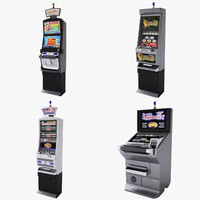Today, the mathematics of slot machines. The University of Houston mathematics department presents this program about the machines that make our civilization run, and the people whose ingenuity created them.
Mathematicians first got interested in randomness by studying games of chance. Ever since, the histories of mathematics and gambling have been intertwined. Clever gamblers use mathematics to look for the smallest advantages, and casinos use sophisticated mathematical tools to devise new ways of drawing in players.
Indeed, a patent granted to the Norwegian mathematician Inge Telnaes in 1984 transformed the gambling industry. Prior to Telnaes’ invention, slot machines were essentially mechanical devices. Besides being difficult to tune and maintain, mechanical slot machines suffered from an essential problem: Let’s look at a machine with three reels, each with 12 symbols, with one of those 12 symbols a cherry. The likelihood of getting three cherries, and winning the jackpot, is 1 in 1,728. If the casino wants to make money, the jackpot payout should be, say $1,700 on a $1 bet. That does not seem attractive by today’s standards. However, the only way to increase the payout is to decrease the chances of hitting a jackpot.
On slot revenues (Lucas, Singh, Gewali, & Singh, 2009). For the fiscal year ending July 31, 2010, Nevada statewide slot machine win was $6.6 billion, compared to $3.5 billion in table games win (Nevada Gaming Control Board, 2010). In 2009, 88% of Illinois’ and 90% of Iowa’s total casino win came from slot machines (Illinois Gaming Board, 2009. Route Management for Slot Machines. View real-time game performance information and make educated decisions on game usage and placement. The m3t route management system also provides extensive meter auditing and configuration ability. Over the past decade, m3t has excelled in VGT performance software with casinos across the country.
Adding another reel is a possibility. For instance adding a fourth reel in the previous example would get us to a jackpot of about $20,000. But people do not like machines with more reels — they intuitively, and rightfully, feel that extra reels diminish their chance of winning. Another possibility is to put more symbols on each reel. But the astronomical jackpots you see in casinos today would then require truly enormous machines.
Inge Telnaes proposed a simple solution: Let a random number generator — a computer chip — determine the combination of symbols that appear when the reels stop. In other words, use a chip to control where the reels stop on a spin, but create the illusion that the wheels stopped on their own. The number of possible outcomes on the slot machine does not change. However, by reprogramming the chip, the operator has full control over the likelihood of each of the different outcomes. For instance, the operator could make the three cherries appear only once in a million spins.
This was a brilliant insight: Suppose I pick a number between one and a million. Would you be willing to bet that you can guess that number? The answer is probably not. But let a computer chip pick such a number, put the chip in a machine with blinking lights and spinning reels, and many people will be more than willing to make the bet. It is simply because what people assume is happening in a slot machine is very different from what is actually happening.
The Magician oil painting by Hieronymus Boschfrom between 1475 and 1480
The history of gambling is also intertwined with that of a less reputable group — tricksters and swindlers. In the long run, the only sure way to make money by gambling is to create the illusion that your opponent can win, while keeping the odds firmly on your side. And that gives those who know math a very solid advantage.

I'm Krešimir Josić, at the University of Houston, where we're interested in the way inventive minds work.

NOTE: In the example with three cherries, I assumed that one only wins in the case the spin results in three cherries, and there is no other winning combination. In actuality, there are typically many winning combination, and as a result, the jackpot would have to be even smaller.
The following story in Wired Magazine shows the drawbacks of the new generation of slot machines — they are easier to hack and to counterfit than their mechanical counterpart http://www.wired.com/magazine/2011/07/ff_scammingslots/.
Here is a more exhaustive discussion of the history of slot machines, and the random number generators within them http://catlin.casinocitytimes.com/article/non-random-randomness-part-1-1243. You may want to scroll towards the end of the article to read about how flaws in the design of gambling machine resulted in somebody picking 19 out of 20 winning numbers in a game of KENO — and doing so 3 times in a row. That person walked away with $620,000, but only after some controversy.
Both images are from Wikipedia. The slot machine image was taken by Jeff Kubina.

For more mathematics in everyday life, visitkjosic.wordpress.com.
Model Netics Models Pdf
This episode was first aired on September 7th, 2011